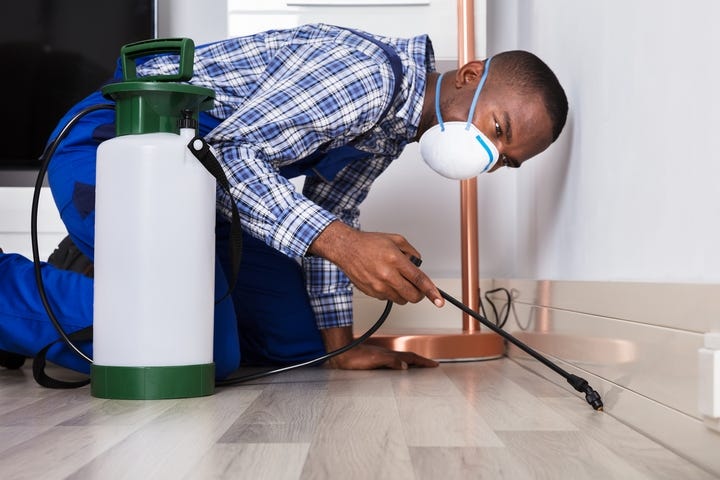Relied On Pest Control Near Me: Quick and Reliable Solutions!
Relied On Pest Control Near Me: Quick and Reliable Solutions!
Blog Article
Specialist Bug Control Techniques for Long-Term Outcomes
In the world of pest control, achieving sustained efficacy and long-term results requires a meticulous approach that goes beyond plain elimination. Specialist parasite control strategies envelop a detailed method that begins with a detailed examination and assessment, adhered to by exact bug identification to understand their actions patterns. The execution of Integrated Bug Administration (IPM) principles, coupled with eco-conscious therapies, develops the foundation of sustainable insect removal. Nonetheless, the true examination hinges on the continuous surveillance and upkeep of the treated areas, guaranteeing a pest-free setting for the direct future. By delving right into the complexities of these strategies, a deeper understanding of specialist insect control approaches for enduring end results emerges.
Evaluation and Evaluation
Upon getting in a building for pest control services, the first step is a comprehensive inspection and analysis to determine the degree of the problem and determine the most efficient therapy strategy. Specialist parasite control specialists are trained to thoroughly check out the premises, searching for signs of insect activity such as droppings, chomp marks, nests, or any type of architectural damages. They will certainly likewise assess the conditions that may be drawing in pests, such as food sources, water leaks, or entry points.

Insect Recognition and Habits

Additionally, understanding the behavior of the determined insect is essential to executing effective control measures. Knowing where parasites nest, what they feed on, and their task patterns can assist pest control experts develop techniques to eradicate them efficiently.
Integrated Parasite Monitoring (IPM)
Integrated Bug Administration (IPM) strategies incorporate numerous methods to control and prevent bug invasions in a lasting and eco-friendly way. Exterminator DC. By integrating approaches such as organic control, habitat adjustment, modification of social practices, and making use of immune varieties, IPM intends to minimize using chemical pesticides
One of the vital principles of IPM is the focus on prevention. This aggressive technique involves surveillance insect populaces on a regular basis to discover any prospective issues before they rise. By determining parasite troubles at an early stage, pest control measures can be carried out promptly and efficiently.
In addition, IPM promotes the usage of non-toxic insect control approaches whenever possible. This can include using natural killers of the bugs, presenting helpful insects, or making use of pheromones to interfere with breeding patterns. By decreasing dependence on chemical pesticides, IPM not just safeguards the atmosphere yet also helps preserve an equilibrium in the ecosystem.
Environmentally-Friendly Treatments
Applying eco-conscious methods in parasite control procedures can efficiently attend to problems while focusing on ecological sustainability. Environmentally-friendly therapies concentrate on minimizing the impact of insect control techniques on environments, non-target microorganisms, and human wellness. These approaches often involve the use of natural predators, such as ladybugs or nematodes, to control pest populations, decreasing the requirement for chemical interventions. Furthermore, strategies like environment adjustment, such as readjusting dampness degrees or getting rid of food resources, can assist prevent bugs without making use of dangerous compounds.
An additional secret aspect of environmentally-friendly treatments is the usage of natural and naturally degradable products that break down promptly without leaving damaging residues in the environment. Agricultural pesticides stemmed from plants like chrysanthemums or neem offer reliable insect control while posing marginal danger to non-target species. Utilizing approaches like warm therapies or pheromone catches can target certain pests with precision, reducing the general ecological effect of parasite control techniques.
Continuous Surveillance and Maintenance
Routine inspections by qualified experts are needed to determine any type of indications of bug activity, evaluate the efficiency of previous treatments, and make adjustments to the insect control plan as required. By monitoring bug populations over time, parasite control professionals can track patterns, anticipate potential issues, and apply preventative actions to bed bug treatment reduce the danger of future infestations.
In enhancement to tracking, maintenance techniques are important for long-term bug control success. This includes applying appropriate sanitation actions to eliminate prospective food and water resources for parasites, securing off entry factors to avoid bugs from getting in the facilities, and dealing with any type of architectural problems that can help with pest problems (bed bug treatment). By incorporating continuous surveillance and upkeep into an integrated pest monitoring approach, services can guarantee a pest-free environment and protect their home versus costly damage and health and wellness risks
Conclusion
In verdict, utilizing professional bug control strategies such as comprehensive assessment and analysis, accurate pest recognition and understanding of their behavior, incorporated pest management techniques, environmentally-friendly therapies, and ongoing tracking and maintenance are essential for attaining long-lasting lead to insect control. By executing these techniques, people can effectively take care of bug infestations and keep a pest-free atmosphere in a lasting way.
Report this page